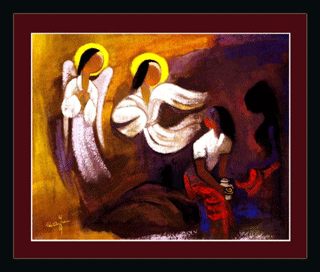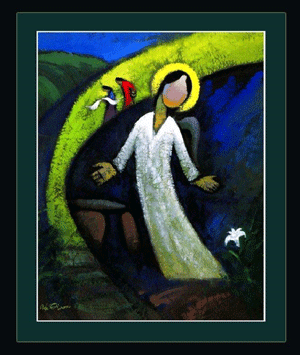Weekly Bible Notes Easter Sunday
Year C, Colour = White or Gold
| Opening Verse |
|
|
| Collect Prayer | ||
| First Reading: | ||
| Second Reading: | ||
| Gospel Reading | ||
| Commentary: | ||
| Meditation: | ||
| Hymns for this week | ||
| Prayers for Sunday and the week ahead : |
 Easter Sunday
Easter Sunday
Introduction
Easter is the greatest of all Christian feasts, and the happy season of Eastertide lasts 50 days from Easter Day until the Feast of Pentecost. St Gregory of Nazianzus said that Easter was ‘like the sun among the stars’ of the other festivals. It is the heart of the sacred calendar, around which all of the other festivals have meaning and purpose. Today is the summit of the Christian year, the fact that Christ is risen shows that God will never leave us, bringing good out of conflict, suffering and death. Easter tells us that just as Christ is risen. so too we can expect to be raised with him to eternal life. As we go into Easter Week we consider that death was only the beginning, Christ is with us forever.
"Hope is not the conviction that something will turn out well, but the certainty that something makes sense, regardless of how it turns out". Vaclav Havel
Risen Lord, give me strength to trust that in your mercy,
you have gone before us from the darkness of the tomb,
to lead all people back to God.
Opening Verse of Scripture Psalm 118:28
You are my God, and I will give you thanks; you are my God, and I will
exalt you. Give thanks to the LORD, for he is good; his love endures
forever.
Collect Prayer for the Day—Before we read we pray
Lord of all life and power,
who through the mighty resurrection of your Son
overcame the old order of sin and death
to make all things new in him:
grant that we, being dead to sin
and alive to you in Jesus Christ,
may reign with him in glory;
to whom with you and the Holy Spirit
be praise and honour, glory and might,
now and in all eternity.
All Amen. CW
First Bible Reading Isaiah 65:17-25
I am about to create new heavens and a new earth; the former things shall not be remembered or come to mind. But be glad and rejoice for ever in what I am creating; for I am about to create Jerusalem as a joy, and its people as a delight. I will rejoice in Jerusalem, and delight in my people; no more shall the sound of weeping be heard in it, or the cry of distress. No more shall there be in it an infant that lives but a few days, or an old person who does not live out a lifetime; for one who dies at a hundred years will be considered a youth, and one who falls short of a hundred will be considered accursed. They shall build houses and inhabit them; they shall plant vineyards and eat their fruit. They shall not build and another inhabit; they shall not plant and another eat; for like the days of a tree shall the days of my people be, and my chosen shall long enjoy the work of their hands.They shall not labour in vain, or bear children for calamity; for they shall be offspring blessed by the LORD – and their descendants as well.Before they call I will answer, while they are yet speaking I will hear. The wolf and the lamb shall feed together, the lion shall eat straw like the ox; but the serpent – its food shall be dust! They shall not hurt or destroy on all my holy mountain, says the LORD. NRSV
Acts Chapter 10:34-43
Peter began to speak to those assembled in the house of Cornelius. ‘I truly understand that God shows no partiality, but in every nation anyone who fears him and does what is right is acceptable to him. You know the message he sent to the people of Israel, preaching peace by Jesus Christ – he is Lord of all. That message spread throughout Judea, beginning in Galilee after the baptism that John announced: how God anointed Jesus of Nazareth with the Holy Spirit and with power; how he went about doing good and healing all who were oppressed by the devil, for God was with him. We are witnesses to all that he did both in Judea and in Jerusalem. They put him to death by hanging him on a tree; but God raised him on the third day and allowed him to appear, not to all the people but to us who were chosen by God as witnesses, and who ate and drank with him after he rose from the dead. He commanded us to preach to the people and to testify that he is the one ordained by God as judge of the living and the dead. All the prophets testify about him that everyone who believes in him receives forgiveness of sins through his name.’ NRSV
Second Reading 1 Corinthians Chapter 15:19-26
If for this life only we have hoped in Christ, we are of all people most to be pitied.
But in fact Christ has been raised from the dead, the first fruits of those who have died. For since death came through a human being, the resurrection of the dead has also come through a human being; for as all die in Adam, so all will be made alive in Christ. But each in his own order: Christ the first fruits, then at his coming those who belong to Christ. Then comes the end, when he hands over the kingdom to God the Father, after he has destroyed every ruler and every authority and power. For he must reign until he has put all his enemies under his feet. The last enemy to be destroyed is death. NRSV
Gospel Reading John 20:1-18
Early on the first day of the week, while it was still dark, Mary Magdalene came to the tomb and saw that the stone had been removed from the tomb. So she ran and went to Simon Peter and the other disciple, the one whom Jesus loved, and said to them, ‘They have taken the Lord out of the tomb, and we do not know where they have laid him.’ Then Peter and the other disciple set out and went towards the tomb. The two were running together, but the other disciple outran Peter and reached the tomb first. He bent down to look in and saw the linen wrappings lying there, but he did not go in. Then Simon Peter came, following him, and went into the tomb. He saw the linen wrappings lying there, and the cloth that had been on Jesus’ head, not lying with the linen wrappings but rolled up in a place by itself. Then the other disciple, who reached the tomb first, also went in, and he saw and believed; for as yet they did not understand the scripture, that he must rise from the dead. Then the disciples returned to their homes.
But Mary stood weeping outside the tomb. As she wept, she bent over to look into the tomb; and she saw two angels in white, sitting where the body of Jesus had been lying, one at the head and the other at the feet. They said to her, ‘Woman, why are you weeping?’ She said to them, ‘They have taken away my Lord, and I do not know where they have laid him.’ When she had said this, she turned around and saw Jesus standing there, but she did not know that it was Jesus. Jesus said to her, ‘Woman, why are you weeping? For whom are you looking?’ Supposing him to be the gardener, she said to him, ‘Sir, if you have carried him away, tell me where you have laid him, and I will take him away.’ Jesus said to her, ‘Mary!’ She turned and said to him in Hebrew, ‘Rabbouni!’ which means Teacher. Jesus said to her, ‘Do not hold on to me, because I have not yet ascended to the Father. But go to my brothers and say to them, “I am ascending to my Father and your Father, to my God and your God.“’ Mary Magdalene went and announced to the disciples, ‘I have seen the Lord’; and she told them that he had said these things to her. NRSV
Post Communion Prayer
God of Life, who for our redemption gave your only-begotten Son to the death of the cross, and by his glorious resurrection have delivered us from the power of our enemy: grant us so to die daily to sin, that we may evermore live with him in the joy of his risen life; through Jesus Christ our Lord. CW
Commentary
It can be very easy for us to just see the resurrection as an historical fact, one which is centrally important to our Christian faith, but the importance of which is as an event which happened in history around 2000 years ago. And the resurrection is indeed a fact. Paul often emphasises the factual reality of the resurrection in his letters, particularly to the Corinthians who wanted to deny this Easter fact but follow the Easter faith. Sometimes our discussions with non believers can centre of the point of whether the resurrection actually happened or not. And as a component of our belief, the fact of the resurrection is crucially important. The fact of the resurrection is that God has won the ultimate victory over those powers which oppose His will and seek to destroy His creation. The fact is that Easter day confirms that God’s mission is accomplished, He has reclaimed creation, albeit with a bit of mopping up to do. The creation that Paul describes in Romans as, ‘subject to frustration’ and ‘groaning’ in its desire to come into its own, has been redeemed, it’s a fact. A creation that includes every one of us has been made whole. Though Christ’s death and resurrection Jesus broke the power of death and opened the way to heaven for each one of us. Through Jesus’ life, He sanctified life; through His death, he gave life to all. It’s the glorious fact of Easter. But the resurrection is more than just a fact, it has implications too. In living out the fact of the resurrection, the church is called to be a witness to the new beginning brought to the world through Jesus. To use the metaphor of John, the Old World Order has passed; the New World Order has come and we are to be living witness to that New World Order. We are called to be that New Creation and are exhorted to call others into the new life we enjoy. Robert Webber writes, ‘Christ is the one in whom life and the new creation, the beginning again of our lives and of all creation is assured. Our Easter calling is to let Him live in us, to embrace by faith His new life, to let it take hold of us, to participate with Him and His resurrection for the life of the whole world. In this way we are born again (Jn 3 v 3) and we are made a new creation (2 Cor 5 v 17)’. This is our Easter spirituality, borne out of the fact of the Easter fact of the resurrection. The link between the Easter fact of the resurrection and our Easter Spirituality is made through how we understand our Easter Christian belief. A belief which calls us to be equally concerned about our participation as it is about our belief in a set of facts.
Looking back over time perhaps helps us understand the two dynamics of our Easter faith. Up until the Middle Ages and the Enlightenment the verb ‘to believe’ had a different meaning to that which is understood today. Before then ‘to believe’ did not mean so much to believe that a statement was true or not, but more that the object of belief, which was always a person, was true and credible. Today we might see this as the difference between ‘believing that’ and ‘believing in’. In our twenty-first century internet connected society the emphasis is much more on facts, data and information, about ‘believing that’ rather than ‘believing in’. But it was not always the case. Moreover, to believe in a person is very different from believing that a statement or series of statements, about a person is true. Believing in somebody implies a relationship of trust and credibility, of loyalty and even love. Thus, in earliest times, to believe in Jesus did not mean so much that a person believed in a set of creedal statements, but that they believed in Jesus the person. It meant I believe (and trust) in Him, to use the phrase from our Baptism service.
Today our belief is based on both a ‘belief that’ and a ‘belief in’. We do believe in a set of creedal statements about who Christ is and what He has done for each one of us and all of creation. This ‘belief that’ is important as it stops us slipping into heresy and forms part of our protestant doctrinal heritage. But its only by ‘believing in’, who Jesus is that our lives can be transformed by the reality of the resurrection as we actively participate in its reality day by day. Simply put, the way of living the resurrected life is through participation, not just an intellectual acknowledgement and agreement with a set of doctrinal principles.
This change between ‘belief that’ and ‘belief in’ is demonstrated in the gospels. Jesus Himself testifies to it in that He does not point outside Himself and say ‘there is the resurrection’, or ‘let me give you some factual details about the resurrection’, as if implying belief that a particular theoretical construct or philosophical system will bring us to new life, He simply points to Himself and says, ‘I am the resurrection’, urging us to simply believe in Him. The difference in ‘believing that’ and ‘believing in’ is also seen in today’s gospel reading. A casual read through the passage shows that there is a lot of ‘seeing’ going on. Mary arrives at the tomb and ‘sees’ that the stone has been rolled away. Peter ‘saw’ the strips of linen. Mary then ‘sees’ two angels. The word that’s used for ‘seeing’ in these cases means ‘to see as an observer’. Mary observed that the stone had been rolled away. Peter observed the strips of linen, Mary observed two angels. But then Jesus reveals Himself to Mary and the words change. She runs back to the disciples and cries out, ‘I have seen the Lord!’ This is now no mere observation or comment from a casual spectator. Mary is no longer looking at Jesus as an observer but as an active participant in the new creation which He brings. Before she may have believed in the fact that Jesus would rise from the dead, now she believes in the risen Christ who has spoken to her personally. It’s an earth-shattering difference. The fact of the resurrection had become a reality in her life. It’s as if an electric shock has gone through her system. The power and energy present in the risen Christ is now present in her life and she runs back to the disciples to proclaim the Good News. Her life would never be the same again. The challenge and encouragement to each one of us this and every Easter is to so experience that same life transforming energy, power and reality in our lives, that we, and the lives of those around us, will never the same again. It’s a step of faith, as inch by inch we transition from the security of ‘believing that’ the resurrection happened, towards the insecurity and Easter adventure that is ‘believing in’ the resurrected Christ, who rose from the grave as saviour of the world and the inaugurator of God’s New creation and world order in, and through, each one of us. Rev Dr Sam Cappleman
Meditation
Today we light the Paschal Candle for Easter 2004, it takes
its name from the Hebrew word ‘Pesach’ meaning Passover. Passover was that
time when the Israelites celebrated their exodus from slavery in Egypt. It
was the feast celebrated by Jesus with the disciples (Maundy Thursday) on
the night before he died. The Paschal Candle is then lit for every service
in our church during the full 50 days of Eastertide. After the solemn weeks
with purple colours of Lent we wear the white of Easter and the brightness
of the candle symbolises the joy of the resurrection.
The sight of a living creature emerging from an egg has long been cherished
as a graphic example of the wonderful new life which is proclaimed at
Easter. The enclosed shell of an egg came to remind people of the sealed
tomb from which the risen Christ emerged victorious over death.
Hymns
-
Christ the Lord
-
This is the Day
-
Led like a lamb (For this hymn will the men please sing ‘Mary’ and the women please respond by singing ‘Master’
-
Thine be the glory
Prayers for Sunday and the week ahead

"Prayer is a plant, the seed of which is sown in the heart of every Christian. If it is well cultivated and nourished it will produce fruit, but if it is neglected, it will wither and die."
Risen Lord Jesus, as Mary Magdalene met you in the garden on the morning of your resurrection, so may we meet you today and every day: speak to us as you spoke to her; reveal yourself as the living Lord; renew our hope and kindle our joy; and send us to share the good news with others. Amen.
God our Father, we come today to worship you and confess that devotion to you is often far from our minds. This morning may we refocus our attention upon our love for you and how we show that love. Help us Lord to be more willing to pour out our lives as fragrant offerings of love. We lay our lives before you and ask that we might know that love which does not count the cost. Lord God, as we wait upon you now, as we listen for your voice in the silence of hearts and as we offer our prayers to you we think of those people in our lives who have loved us with a generous love we think of those who like Mary have not counted the cost of what they have given us; of those who given all of themselves to us as Christ gave himself for the world; and we thank you for them - and ask you to bless them and for you to make us like them. As we go into this week, O God, help us to have a focus, a purpose that is beyond that of just getting by; beyond that of just trying to make it through another week; show us we pray what you would have us do; reveal to us our own personal and unique ministry—and help us to do it.
Bless O God those in our midst and those around the world whom we name in our hearts before you at this time; we especially ask for those who are poor in the basic needs of daily living; and for those who are poor in love; hear too the prayers we ask for those who need healing or hope in their lives, those who need justice, and those who require mercy.
Additional Resources
Liturgy for the lighting of the Paschal Candle
at the beginning of our service.
Minister: Jesus Christ yesterday and today
the beginning and the end
Alpha and Omega
all time belongs to him
and all ages;
to him be glory and power
through every age and for ever. Amen.
All: By his holy and glorious wounds
may Christ our Lord guard and keep us. Amen.
The candle is lit as the Minister says the following words
May the light of Christ, rising in glory
banish all darkness from our hearts and minds
Minister: The light of Christ
All: Thanks be to God
Minister: Alleluia! Christ is risen.
All: He is risen indeed, Alleluia!
The Easter Blessing used at the end of our Easter Service
The God of peace, who brought again from the dead our Lord
Jesus, that great shepherd of the sheep, through the blood of the eternal
covenant, make you perfect in every good work to do his will, working in you
that which is well-pleasing in his sight; and the blessing of God almighty,
the Father, the Son, and the Holy Spirit, be among you and remain with you
always.
All: Amen.
Commentary
Lesslie Newbigin warned about the misunderstanding created by the medieval crucifix, which shows Jesus as a drooping, defeated, pain-drenched figure - a symbol of abject submission and defeat. This picture of the cross as the defeat of goodness by the powers of evil has been enormously influential in Spanish Christianity and is part of the background of Latin American liberation theology. In English, when we want to express our pity for a helpless victim of circumstances, we are inclined to exclaim: 'Poor devil.' The Spanish equivalent of this expression is 'Poor Christ!'
But the earliest representations of the crucifixion do not portray it like this. They depict Christ with head erect, the warrior beating down the powers of death and hell, the victorious challenger of all the powers of evil. This is the > understanding of the cross as the New Testament teaches us. The cross is not abject submission to the power of evil; it is the price that paid for a victorious challenge to the powers of evil.
And so the final act of this triumph on the cross is celebrated today in the events of the resurrection. The battle has already been won but the disciples do not yet know it. The resurrection is nothing more than conformation of something that Jesus had shouted from the cross was 'finished'. In a sense the resurrection is therefore not a miracle at all, it is the natural consequence of the defeat of death which Jesus secured-on the cross. That was the turning point -'crux'- this is now the proof. Praise God.
Meditation
John Bunyan's Pilgrim's Progress includes this famous incident:
"Up this way, therefore, did burdened Christian run, but not without
great difficulty, because of the load on his back. He ran thus till he came
to a place somewhat ascending; and upon that place stood a Cross, and a
little below, in the bottom, a Sepulchre. So I saw in my dream, that just as
Christian came up with the Cross, his burden loosed from his shoulders, and
fell off his back, and began to tumble, and so continued to do, till it came
to the mouth of the Sepulchre, where it fell in, and I saw it no more. Then
was Christian glad and lightsome, and said with a merry heart, He hath given
me rest by his sorrow, and life by His death."
Bunyan concludes, "Then Christian gave three leaps for joy, and went on his
way singing."
Easter is a time for joyful leaps and singing hearts.
Hymns for Sunday - Mission Praise
- Christ the Lord is risen today
- There is a Redeemer
- My God and is thy table spread
- If Christ had not been raised
- Thine be the glory
 Be thou comforted, little dog,
Be thou comforted, little dog,
Thou too in Resurrection
shall have a little golden tail.
Martin Luther, 16th century


